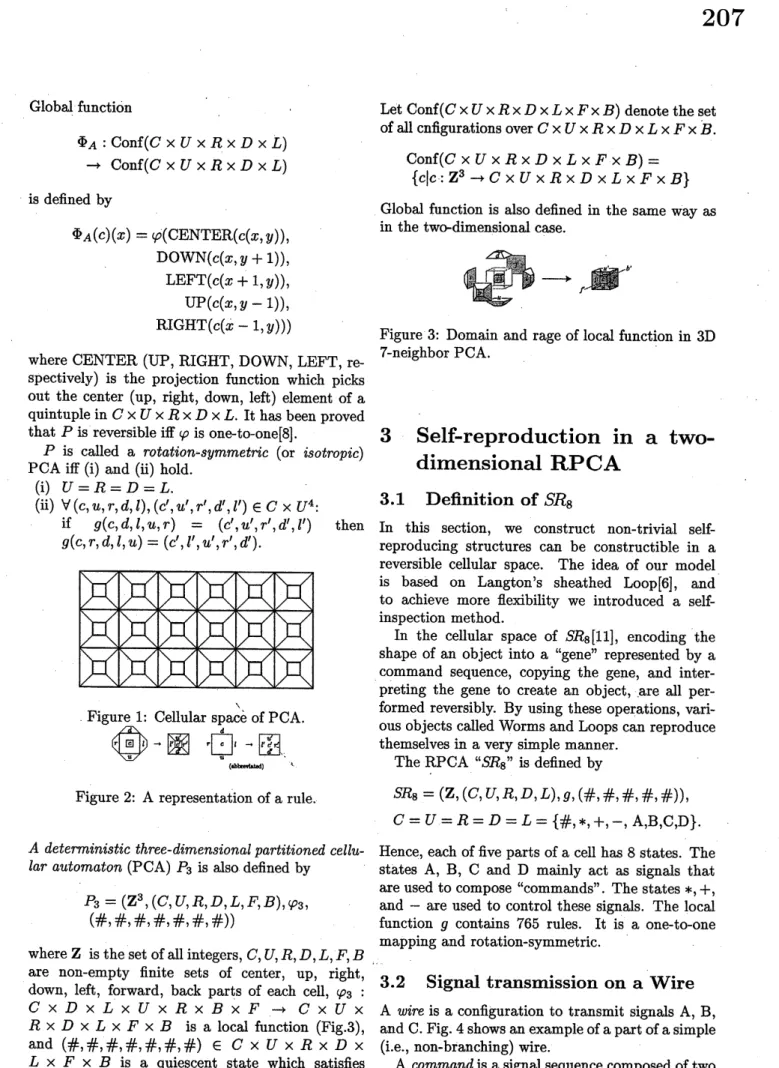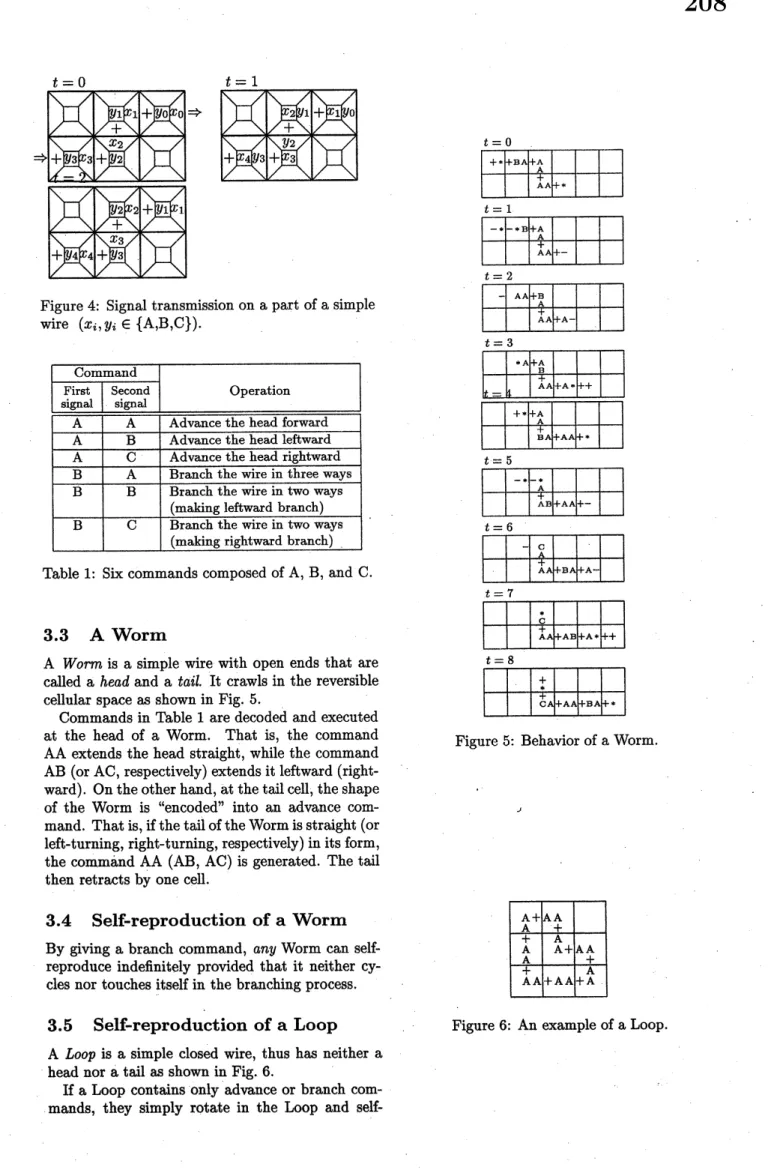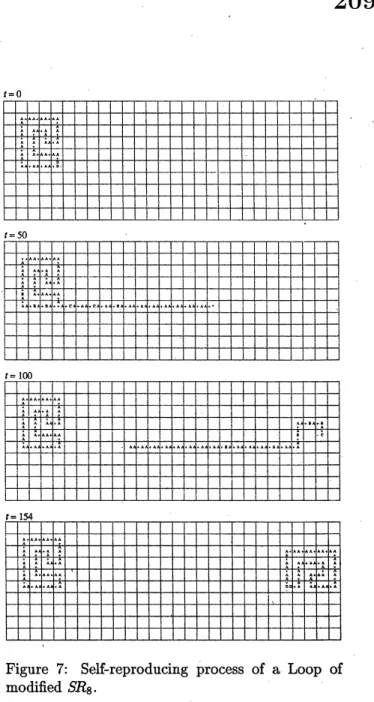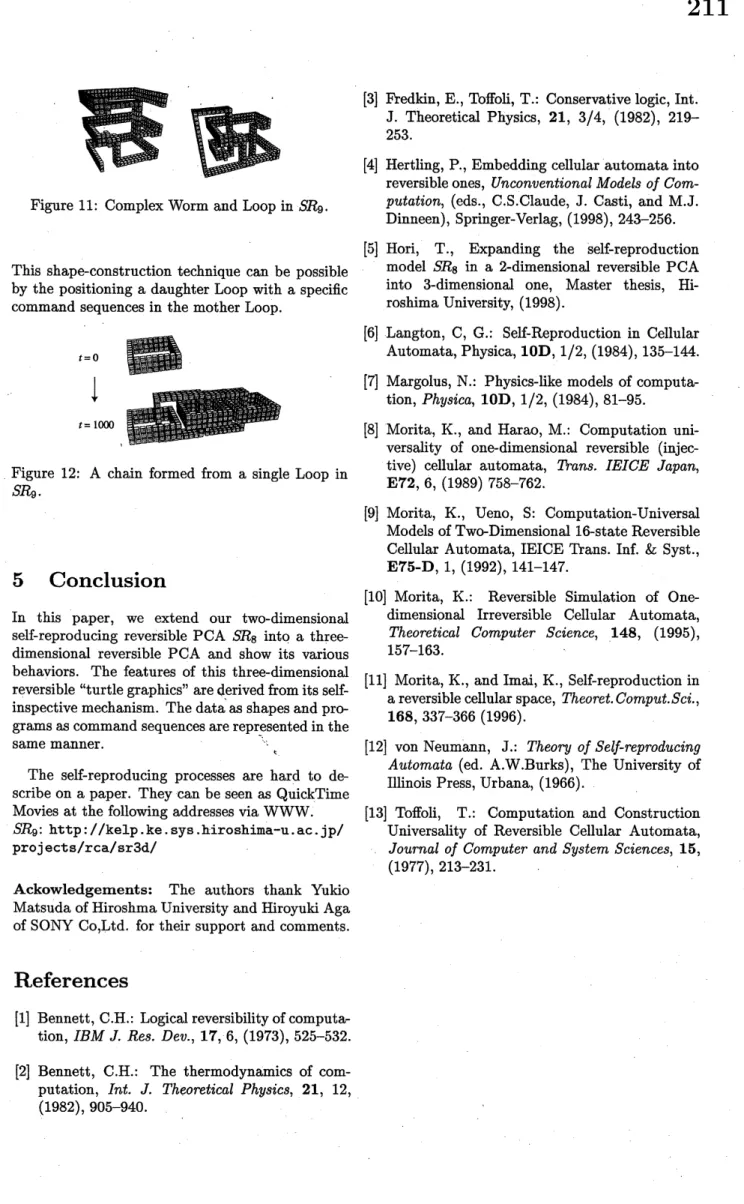3
次元可逆自己増殖セルオートマトンについて
堀貴博$\dagger$, 今井克暢,
森田憲–
f \dagger NEC アイシーマイコンシステム thori@nims.nec.co.jp \ddagger 広島大学工学部{imai,
$\mathrm{m}\mathrm{o}\mathrm{r}\mathrm{i}\mathrm{t}\mathrm{a}$}
$@\mathrm{k}\mathrm{e}.\mathrm{S}\mathrm{y}\mathrm{s}.\mathrm{h}\mathrm{i}\mathrm{r}\mathrm{o}\mathrm{S}\mathrm{h}\mathrm{i}\mathrm{m}\mathrm{a}-\mathrm{u}.\mathrm{a}\mathrm{c}.\mathrm{i}\mathrm{p}$1
Introduction
A reversible cellular automaton (RCA) is one of
the reversible computing models. Its global
func-tion is injective and every configuration has at
most
one
predecessor. Intuitively, it “remembers”the initial configuration and one can reconstruct
its initial configuration from a configuration of
any time. So reversible property is a strong
con-straintand one cannot generate norextinct signals
freely. Toffoli showed that there exist
computation-universal $\mathrm{R}\mathrm{C}\mathrm{A}\mathrm{s}[13]$ and theBBM cellular
automa-ton (BBMCA),
was
introduced by $\mathrm{M}\mathrm{a}\mathrm{r}\mathrm{g}\mathrm{o}\mathrm{l}\mathrm{u}\mathrm{s}[7]$. Itiscomputation-universaland it hasadirect relation
withaphysicalreversibleandconservative
comput-ing model(theBilliard Ball$\mathrm{M}\mathrm{o}\mathrm{d}\mathrm{e}\mathrm{l}$)$[3]$
.
TheBilliardBallModel (BBM) has animportantaspect that it
ispossibletocomputeany function without
dissipa-tion of ballsasgarbage. OncevonNeumann
conjec-tured that computing without erasinginformation
isimpossible anderasingone-bit information must
dissipate at least $ln2kT$joules of energy. But the
BBM is a conservative model and it is possible to
construct a computer that can computes with no
energy dissipationin principle.
This fact means garbage collection can be
per-formed with reversed sub-computations and such
garbage collectorcanbeconstructed with reversible
manner. This techniqueis first introducedby
Ben-nett. He showedthathis reversible Turing machine
iscomputation-universaland garbage collectioncan
be implemented in reversible$\mathrm{m}\mathrm{a}\mathrm{n}\mathrm{n}\mathrm{e}\mathrm{r}[1,2]$
.
Butthefact does not mean any computing process can be
simulated effectively in$\mathrm{r}\mathrm{e}\mathrm{v}\mathrm{e}\mathrm{r}\mathrm{s}\mathrm{i}\mathrm{b}\mathrm{l}\mathrm{e}[10,4]$
.
Especially,it is verydifficulttoplaceapreferredinitial
configu-rationand start computingonreversiblecomputing
models. This problem is described as arestriction
ofgenerationand extinction ofsignalsin RCAs,and
synchronizing signals and distributingspecific
pat-terns
on
RCAsare
alsoquite difficult.So we proposed a simple self-reproducing RCA
based on a shape-encoding mechanism $(SR_{8})1^{1}1]$.
In $SR_{8}$, self-reproduction can be performed
with-out garbage in two-dimensional reversible cellular
space.
In this paper, we extend $SR_{8}$ into
three-dimensional reversible cellularsp\‘ace. Even if its
cel-lular spaceis reversible, it can self-reproduce
vari-ousthree-dimensionalpatterns
wi.thout
garbagedis-sipation. Inordertodesignan RCAwe use a
frame-work of partitioned cellular automaton (PCA). In
thenext section,first
we
define PCA.2
Definitions
Partitioned cellular automaton $(\mathrm{P}\mathrm{C}\mathrm{A})[8]$ is
re-garded
as
thesubclass of standard cellularautoma-ton. Each cellis partitioned intothe equalnumber
ofpartstotheneighborhood size and the
informa-tion stored in each part is sent to only one ofthe
neighboring cells (Fig. 1). In PCA, injectivity of
global function is equivalent to injectivity of local
function, thusa PCA is reversible if its local
func-tion is injective. Using PCA, we can construct a
reversible CAwith ease.
A $dete\Gamma min\dot{i}sti_{C}$ two-dimensionalpartitioned
cel-lular automaton (PCA) $P$is defined by
$P=(\mathrm{Z}^{2}, (C, U,R, D, L), \varphi, (\#, \#, \#, \#, \#))$
where $\mathrm{Z}$ is the set of all integers, $C,$$U,$$R,$$D,$$L$ are
non-emptyfinite sets ofcenter, up, right,down, left
parts of each cell, $\varphi$
:
$C\cross D\cross L\mathrm{x}U\cross Rarrow$$C\cross U\mathrm{x}R\cross D\mathrm{x}L$ is a local function (Fig.2),
and $(\#, \#, \#, \#, \neq)\in C\mathrm{x}U\mathrm{x}R\cross D\cross L$ is a
quiescent state which satisfies $\varphi(\#, \#, \#, \#. ’\#)=$
$(\#, \#, \#, \#, \neq)$
.
A configuration
over
$C\cross U\mathrm{x}R\mathrm{x}D\cross L$ is amapping$c:\mathrm{Z}^{2}arrow C\cross U\cross R\cross D\cross L$
.
Let Conf$(C\cross$ $U\cross R\cross D\cross L)$denote the set of all configurationsover $C\cross U\mathrm{x}R\mathrm{x}D\cross L$
.
Conf$(C\cross U\cross R\cross D\cross L)=$
LEFT$(c(x+1,y))$,
UP$(c(_{X},y-1))$,
RIGHT$(c(x-1,y)))$
where CENTER(UP, RIGHT, DOWN, LEFT,
re-spectively) is the projection function which picks
out the center (up, right, down, left) element ofa
quintuplein$C\cross U\cross R\cross D\cross L$
.
It has beenprovedthat $P$is reversible iff$\varphi$ is$\mathrm{o}\mathrm{n}\triangleright \mathrm{t}_{0}-o\mathrm{n}\mathrm{e}[8]$
.
$P$ is called a rotation-symmetric (or isotropic)
PCA iff (i) and (ii) hold.
(i) $U=R=D=L$.
(ii) $\forall(c, u, r, d, l),$$(c’,urd^{;}’,’,, l’)\in C\cross U^{4}$:
if $g(c, d, l,u, r)$ $=$ $(c’,urd”,’,, l’)$ then
$g(c, r, d, l, u)=(c’, l’,du’,r’,’)$
.
Figure 1: Cellular space ofPCA.
$\copyright_{u}r$
$rua_{1\cdot \mathrm{b}-)}e\iotaarrow ld\mathrm{E}$
Figure 3: Domain andrageof localfunction in $3\mathrm{D}$
$7$-neighborPCA.
3
Self-reproduction
in
a
two-dimensional RPCA
3.1
Definition
of
$SR_{8}$In this section, we construct non-trivial
self-reproducing structures can be constructible in a
reversible cellular space. The idea of
our
modelis based on Langton’s sheathed $\mathrm{L}\mathrm{o}\mathrm{o}\mathrm{p}[6]$, and
to achieve more flexibility we introduced a
self-inspection method.
In the cellular space of $SR_{8}[11]$, encoding the
shape of
an
object into a “gene” represented by acommand sequence, copying the gene, and
inter-preting the gene to create an object,
are
allper-formed reversibly. By using these operations,
vari-ous objects called Worms andLoops
can
reproducethemselves ina very simplemanner.
The RPCA (
$‘ SR_{8}$” is defined by
Figure 2: Arepresentationofarule.
A deterministic three-dimensionalpartitioned
cellu-larautomaton (PCA) $P_{3}$ is alsodefinedby
$P_{3}=(\mathrm{Z}^{3},$$(C, U, R, D, L, F, B),$
$\varphi 3$,
$(\#, \#, \#, \#, \#, \neq, \#))$
where$\mathrm{Z}$ is the set of all integers,$C,$ $U,$
$R,$$D,L,$$F,$ $B$
are non-empty finite sets of center, up, right,
down, left, forward, back parts of each cell, $\varphi_{3}$ :
$C\cross D\cross L\mathrm{x}U\cross R\cross B\cross Farrow C\cross U\cross$
$R\mathrm{x}D\cross L\cross F\cross B$ is a local function (Fig.3),
and $(\#, \#, \#, \#, \#, \#, \#)\in C\cross U\cross R\cross D\cross$
$L\mathrm{x}F\cross B$ is
a
quiescent state which satisfies$\varphi_{3}(\#, \#, \#, \#, \neq, \#, \#)=(\#, \#, \neq, \#, \#, \#, \#)$
.
Aconfiguration over$C\mathrm{x}U\cross R\cross D\cross L\cross F\cross B$
isamapping$c:\mathrm{Z}^{3}arrow C\cross U\cross R\cross D\cross L\cross F\cross B$.
$SR_{8}=(\mathrm{Z}, (C, U, R, D, L),g, (\#, \#, \#, \#, \#))$,
$C=U=R=D=L=\{\#, *, +, -, \mathrm{A},\mathrm{B},\mathrm{C},\mathrm{D}\}$
.
Hence, each of fiveparts ofa cellhas 8 states. The
states $\mathrm{A},$ $\mathrm{B},$ $\mathrm{C}$ and $\mathrm{D}$ mainly act as signals that areusedto compose “commands”. The $\mathrm{s}\mathrm{t}\mathrm{a}\mathrm{t}\mathrm{e}\mathrm{s}*,$$+$,
and
–are
used to control these signals. The localfunction $g$ contains 765 rules. It
is.
a one-to-onemapping and $\mathrm{r}\mathrm{o}\mathrm{t}\mathrm{a}\mathrm{t}\mathrm{i}\mathrm{o}\mathrm{n}arrow \mathrm{s}\mathrm{y}\mathrm{m}\mathrm{m}\mathrm{e}\mathrm{t}\mathrm{r}\mathrm{i}\mathrm{c}$
.
3.2
Signal
transmission on
a Wire
A wire is a configurationto transmit signals $\mathrm{A},$ $\mathrm{B}$,
andC. Fig.4 shows
an
exampleofapartofasimple(i.e., non-branching)wire.
A command isasignalsequencecomposedoftwo
signals. There
are
six commands consisting ofsig-nals $\mathrm{A},$ $\mathrm{B}$ and $\mathrm{C}$ as shown in Table 1. These
Figure4: Signal transmissionon a part ofasimple wire $(x_{i},y_{i}\in\{\mathrm{A},\mathrm{B},\mathrm{C}\})$
.
Table 1: Sixcommandscomposedof$\mathrm{A},$ $\mathrm{B}$, and C.
3.3
A Worm
A Wormis a simple wire with open ends that are
called ahead and a tail. It crawls in thereversible
cellular spaceas shownin Fig. 5.
Commandsin Table 1 aredecoded and executed
at the head of a Worm. That is, the command
AA extends the head straight, while the command
AB (or$\mathrm{A}\mathrm{C}$, respectively)extends it leftward
(right-ward). On the otherhand,at the tailcell,theshape
of the Worm is “encoded” into
an
advancecom-mand. Thatis,if the tail of the Worm is straight(or
left-turning, right-turning,respectively)in itsform,
thecommand AA (AB, $\mathrm{A}\mathrm{C}$) is generated. The tail
then retractsby
one
$\mathrm{c}\mathrm{e}\mathrm{U}$.
3.4
Self-reproduction of
a
Worm
Figure 5: Behavior ofaWorm.
Bygiving abranch command, any Worm
can
self-reproduce indefinitely providedthat it neither
cy-clesnortouches itself in thebranchingprocess.
3.5
Self-reproduction
of
a
Loop
Figure6: An exampleofaLoop.A Loop is asimple closed wire, thus has neither a
head
nor a
tailas
shown in Fig. 6.Ifa Loop contains only advance
or
branchself-reproduction does not occur. In order to make a
Loop self-reproduce,commandsinTable2areused.
Byputtingacommand DB at anappropriate
po-sition, everyLoophavingonlyAA commandsinall
the other cellscanself-reproduce in this way. When
DB reachesthe bottom right corner,it starts
mak-ing an “arm” and this corner become a
transmit-ter of commands. First, all AA commands in the
motherLoop aretransmitted throughthe armand
generatedDCcommands encode wholeshapeof the
mother Loop into command sequences
simultane-ouslyand thesecommands
are
transmittedafter allstatic AA commands
are
transmitted. FinallyDCcommandsreaches the bottomright
corne.r
and thearmis splitfrom themotherLoop.
3.6
Controlling
the
position
of
daughter Loops
in
$SR_{8}$One of
our
main motivations is to place preferredinitial patterns to a reversible cellular space. As
mentioned above,
a
closed Loop hasonly AAcom-mands. If AB or AC commands
are
placed in theLoop, generatedposition of the daughterLoop
can
be changed.
But DB (create an
arm
command) advances thebottom side ofa loop and the length of the Loop
does not equal to the running lengthof the whole
commands. Thus the embedded position of
turn-ing commandsinthe daughterLoopdiffer from the
mother Loop.
Although suchashiftingof reading-frames of its
command sequence isinterestingphenomenon,it is
difficult to control. So we modify $SR_{8}\mathrm{f}\dot{\mathrm{o}}\mathrm{r}$ solving
this timingproblem. .
Fig.7 is the process of modified version of $SR_{8}$
.
DB signalisnot$\mathrm{a}\mathrm{d}\dot{\mathrm{v}}\mathrm{a}\mathrm{n}\mathrm{C}\mathrm{e}$bottom
side and the
repro-ducing process startsfrom the bottom right
corner
as
soon as
the Worm reaches at this position. Socreated daughterLoopis rotated in90 degrees.
Be-cause
of this rotation, Loops make collision after 4generations. But this collision
can
be avoidablebyinserting direction commands into the motherLoop
(Fig.8) andthismodification actsimportant$\mathrm{r}\mathrm{o}\mathrm{U}$in
extending$SR_{8}$ tothree-dimensional
one
in the nextsection.
Figure 7: Self-reproducing process of a Loop of
modified $SR_{8}$
.
4
Self-reproduction
in
a
three-dimensional
RPCA
4.1
Three-dimensional
self-reproducing RPCA
$(SR_{9})$In this section, we extend $SR_{8}$ into a
three-dimensionalRPCA.
A two-dimensional 5-neighbor PCA can be
em-beddeddirectlyintoathree-dimensional 7-neighbor
PCA. But due to the rotation-symmetric
condi-tion of$SR_{8}$, theWorm cannot know the directions
of right, left, up and down. In three-dimensional
rotation-symmetric $\mathrm{C}\mathrm{A}$, up to 24 rotated rules
are
regarded as the
same
rule. Sowe
introducean-other glue state $‘=$ ’ for $SR_{8}$ and combine two
Worms whose command sequences are
complemen-talyplaced
as
presented intable 3.Figure 9: Fourkind ofturnsin $SR_{9}$
.
width 2 ladder approach in the previous section is
impossible. So
we
adda center wire and Fig.10isasimple Worm in $SR_{9}$
.
Figure 10: AsimpleWorm in $SR_{9}$
.
Figure 8: Self-reproducing process of a Loop of
modified $SR_{8}$
.
“$SR_{9}$” isdefined by $SR_{9}=(\mathrm{Z}^{3},$$(C, U, R, D, L, F, B),$$g$, $(\#, \#, \#, \#, \#, \#, \#))$,$C=U=R=D=L=F=B=$
$\{\#, *, +, -, =, A,B, C, D\}$..
Localrules areavailable via WWW.http:$//\mathrm{k}\mathrm{e}\mathrm{l}\mathrm{p}.\mathrm{k}\mathrm{e}$
.
sys.hiroshima-u.$\mathrm{a}\mathrm{c}.\mathrm{j}\mathrm{p}/$ $\mathrm{P}^{\mathrm{r}\mathrm{o}}\mathrm{j}\mathrm{e}\mathrm{c}\mathrm{t}\mathrm{s}/\mathrm{r}\mathrm{c}\mathrm{a}/\mathrm{s}\mathrm{r}3\mathrm{d}/$Although $SR_{9}$ has6886rules, if rotated rules
are
regarded
as
equivalent, it becomeonly338$\mathrm{r}\mathrm{u}\mathrm{l}\mathrm{e}\mathrm{s}[5]$.
To construct ‘true’three-dimensionalstructures,
a
Worm in $SR_{9}$ can twist its head in $\pm 90$ degrees(Fig.9). This can be possible by employing ribbon
of width 3 shaped Worms. As far as using $SR_{8}$
command sequences in rotation-symmetric spaces,
the lengthof thepathshould bekept equaland the
When both wires of a three-dimensional Worm
have the same sequence ‘AB AA $\mathrm{A}\mathrm{C}$’ (or ‘AC AA
AB’), its head istwisted leftward (rightward).
Us-ingtwistingcommands, complexthree-dimensional
Worms andLoops such asFig.11 areconstructible.
Although the existence of twisting commands in
$SR_{9}$, its self-reproducing mechanism is completely
thesame asthat of$SR_{8}$
.
4.2
Controlling
the
position
of
daughter Loops
in
$SR_{9}$When extending $SR_{8}$ to $SR_{9}$,
we use
themodi-fied version of $SR_{8}$ discussed in section 3.6. So
Loop positioning commands can also be inserted
freely in$SR_{9}$
.
And thismodificationhas animpor-tant meaninginthe three-dimensional
case
becauseit makes possible to generate different topological
This shape-construction technique can be possible
bythe positioning a daughter Loop witha specific
command sequences in the mother Loop.
Figure 12: A chain formed from a single Loop in
$SR_{9}$
.
5
Conclusion
In this paper, we extend our two-dimensional
self-reproducing reversible PCA $SR_{8}$ into a
three-dimensional reversible PCA and show its various
behaviors. The features of this three-dimensional
reversible “turtlegraphics”are
d.erived
from itsself-inspectivemechanism. The dataasshapesand
pro-gramsascommandsequencesarerepresentedinthe
$arrow\backslash \backslash$
same
manner. $\mathrm{k}$The self-reproducing processes
are
hard tode-scribeon apaper. Theycan beseen asQuickTime
Movies at the following addresses via WWW.
$SR_{9}$: http:$//\mathrm{k}\mathrm{e}1_{\mathrm{P}}.\mathrm{k}\mathrm{e}$ .sys.hiroshima-u.$\mathrm{a}\mathrm{c}.\mathrm{j}\mathrm{p}/$ $\mathrm{p}\mathrm{r}\mathrm{o}\mathrm{j}\mathrm{e}\mathrm{C}\mathrm{t}\mathrm{S}/\mathrm{r}\mathrm{c}\mathrm{a}/\mathrm{s}\mathrm{r}3\mathrm{d}/$
Ackowledgements: The authors thank Yukio
Matsuda of Hiroshma University and HiroyukiAga
ofSONY Co,Ltd. for their support andcomments.
References
[1] Bennett,C.H.: Logical reversibilityof
computa-tion, IBM J. Res. Dev., 17, 6, (1973), 525-532.
[2] Bennett, C.H.: The thermodynamics of
com-putation, Int. J. Theoretical Physics, 21, 12,
(1982), 905-940.
model $SR_{8}$ in a 2-dimensional reversible PCA
into 3-dimensional one, Master thesis,
Hi-roshima University, (1998).
[6] Langton, C, G.: Self-Reproduction in Cellular
Automata, Physica, 10D, $1/2$, (1984), 135-144.
[7] Margolus, N.: Physics-like models of
computa-tion, Physica, 10D, $1/2$, (1984), 81-95.
[8] Morita, K., and Harao, M.: Computation
uni-versality of one-dimensional reversible
(injec-tive) cellular automata, Trans. IEICE Japan,
E72, 6, (1989) 758-762.
[9] Morita, K., Ueno, S: Computation-Universal
Models of Two-Dimensional16-state Reversible
Cellular Automata, IEICE hans. Inf. &Syst.,
E75-D, 1, (1992), 141-147.
[10] Morita, K.: Reversible Simulation of
One-dimensional Irreversible Cellular Automata,
Theoretical Computer Science, 148, (1995),
157-163.
[11] Morita, K., and Imai, K., Self-reproduction in
areversiblecellular space, Theoret. Comput.Sci.,
168, 337-366(1996).
[12]
von
Neumann, J.: Theoryof
Self-reproducingAutomata (ed. A.W.Burks), The University of
Illinois Press, Urbana, (1966).
[13] Toffoli, T.: Computation and Construction
Universality of Reversible Cellular Automata,
Journal




